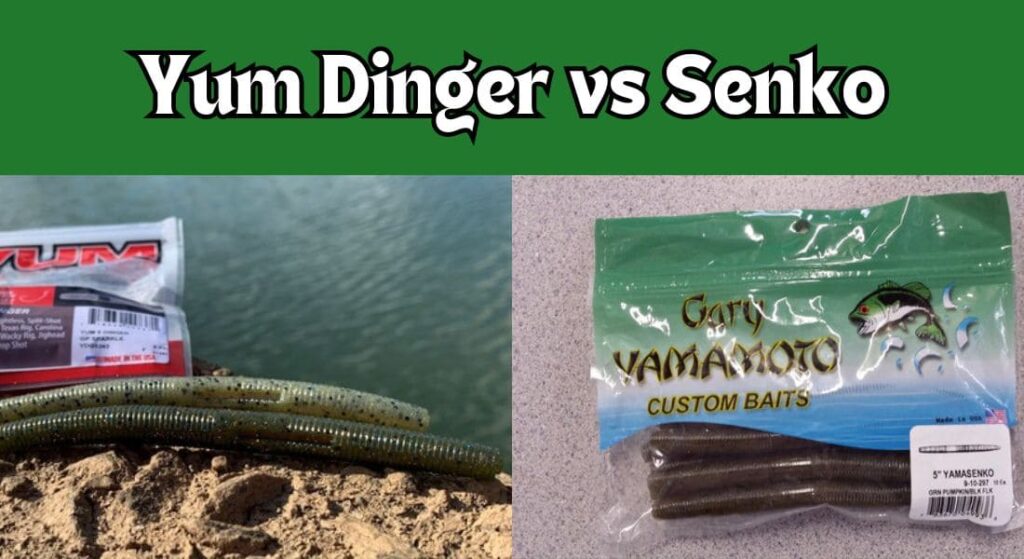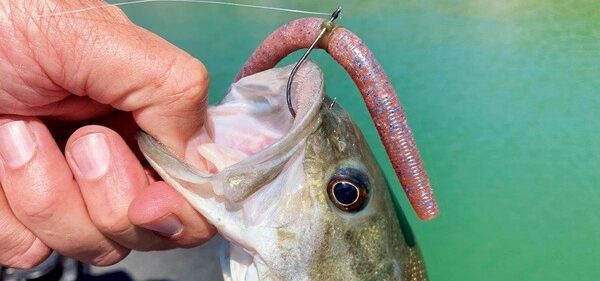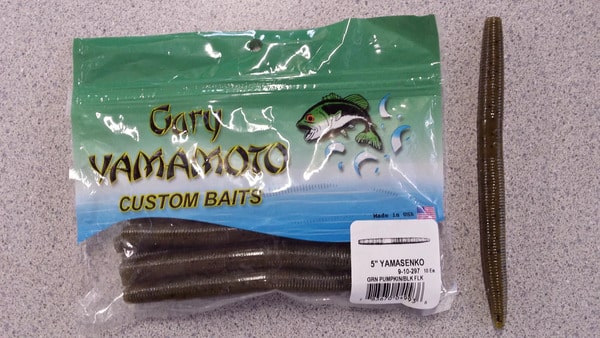Yum Dinger vs Senko: Which is Better?

The Yum Dinger and the Gary Yamamoto Senko are the two most popular soft plastic stick baits on the market.
But which one is better? And which one should you get?
We’re about to go down the list and break down each part of these baits that you need to worry about.
Why the Debate?
There actually aren’t that many pieces of fishing tackle that get pinned against each other like this.
Almost every brand makes the same general products, and they are pretty much all the same.
So why are the Yum Dinger and the Gary Yamamoto Senko pinned up against each other so fiercely?
Well, about 10 years ago, the stick baits style soft plastic became extremely popular.
The Senko was the first one ever made, and is responsible for the popularity of stick baits.
The next popular stick bait was the Yum Dinger. It was much cheaper, easier to get your hands on, and almost seemed too good to be true.
And ever since, these two soft plastics have become to most popular stick baits out there, and are always being compared to one another.
Overall Profile

As you can probably imagine, the profiles of the two baits are exactly the same.
I mean, they’re stick baits, so you it’s not like there can even be much difference.
The only actual difference between the Dinger and the Senko is that the Dinger has a hook slot on the top of the bait.
This allows you to rig it up weedless a bit easier without having to texpose the hook point.
But in the water, you can’t even really see that slot, so it doesn’t change much visually. Neither bait wins or loses when it comes to profile.
Winner: Tie
Speed of Fall
The speed of fall is how quickly each bait sinks in the water.
The most popular way to rig stick baits is without any weight, and lots of your bites come on that slow fall.
The Dinger falls a bit slower than the Senko. For me, this is a good thing, because I like to fish stick baits in real shallow water.
That slow fall gives bass more time to see your bait and swim over to eat it.
However, if you are fishing a bit deeper water, a faster sinking Senko will likely be better, so that you don’t have to wait all day for your bait to reach the bottom.
So the speed of fall is a bit situational, but since stick baits are primarily a shallow water bait, I’m giving the win to the Yum Dinger.
Winner: Yum Dinger
Action on the Fall
A lot of the bites that you get when fishing stick baits will come while the bait is falling towards the bottom.
As we discussed above, this is why you usually want your stick baits to slowly fall.
But the other factor is how the bait moves as it falls. You want to stick bait to shimmy and wiggle as it sinks.
And for this one, the Senko definitely comes out on top. As the Senko sinks, it has a very distinct and enticing shimmy and wiggle.
It looks very, very good, and this falling action is the number one reason people use Senkos over other stick baits.
The Yum dinger has a small bit of action on the fall, but it can be hard to see unless you get up real close to it.
For the most part, the Dinger just slowly falls, almost completely still.
Winner: Senko
Action On the Retrieve
Stick baits are typically fished very slowly, with long pauses to let the bait sink.
So the fall is actually a very large part of the retrieve as well. But even as you twitch or drag the bait along, it will have some movement and action as well.
The Yum Dinger certainly has much wider, quicker movements on a twitching retrieve.
However, the Senko has more body movement and will very subtly slither as it is twitched or dragged.
Now, stick baits are rarely fished with aggressive twitches or quick movements.
So I think the shimmying fall and the more bendy body give the Senko a bit better action while being retrieved.
Winner: Senko
Scent/Taste
To be honest, I have no idea which of the baits is better in this category.
They each smell different, and I can imagine the taste different as well (although I’ve never tested that out myself).
But I have no clue which scent/taste the bass prefer to eat.
And more importantly, I have never noticed that bass hold on longer or commit to one better because of that scent/taste.
So for this one, it’s going to be another tie.
Winner: Tie
Durability
When it comes to the biggest differences between these baits, durability might just be number one.
I mean it’s the first thing I ever noticed when comparing these baits years ago.
The Yum Dinger is way, way more durable than the Senko. I am usually able to catch 2-4 bass on the same Dinger before it tears off and I need a new one.
But with the Senko, I have almost never been able to catch more than one bass on a single one.
And sometimes, the bait will get so torn up just by casting, hitting the water, skipping, or coming through cover that I need to replace it without even catching a single fish.
The main reason for this is the large salt content that the Senkos have in them.
This sale is beneficial in other ways, but makes the baits incredibly fragile.
Winner: Yum Dinger
Price
This is another pretty stark difference between the Dinger and the Senko.
The Dinger comes in around 3-4 bucks and the Senko is about 7-8.
The Senko actually used to be even more expensive, but it has dropped by a couple dollars per pack in the last few years.
But the Senko is over two times as expensive as the Dinger. And considering that it is also much less durable, that price is multiplied again by 3-4 times.
So when it comes to price, the Yum Dinger is far, far cheaper than the Senko.
And since stick baits get so many bites, your going to go through a lot of them, and price is quickly going to become a big factor.
Winner: Senko
Available Colors

Both these baits come in pretty much any color you could imagine.
The Dinger comes in over 70 colors and the Senko in over 130 colors. But the truth is, you really only need 1-3 colors that will cover every situation.
In fact, I kind of wish that these companies only made a very small amount of colors so that they’re easier to pick out when I’m shopping for them.
But both companies make plenty of great color options (truthfully they both make too many), so this one is a tie.
Your not going to catch any more bass with one’s colors over the other’s.
Winner: Tie
Also Read: Best Color Senkos
Overall Ratings for Each
Dinger: 8/10

The biggest downside of the Dinger is that it doesn’t have much action as it sinks.
However, I have always had plenty of success with it, and bass don’t seem to mind whether it is shimmying or not.
The Dinger is durable and cheap, which is a huge benefit, especially for casual fisherman who aren’t being paid to fish.
Senko: 6/10

That rating might seem a little bit harsh, but the durability and price are a huge deal for me.
I just can’t stand how fragile Senkos are, and when you factor in their high price as well, they’re really just a poor financial choice.
Maybe they get you 5-10% more bites, but unless you are a competitive fisherman who is getting paid or sponsored to catch fish, Senkos are just not worth that.
Reeling this In
Both the Yum Dinger and the Gary Yamamoto Senko have their strengths and weaknesses, making them the top choices for soft plastic stick baits on the market.
The Yum Dinger stands out for its affordability, durability, and slower fall, making it ideal for shallow water fishing and providing great value for casual anglers.
On the other hand, the Gary Yamamoto Senko excels with its enticing action on the fall and subtle movement during retrieval, which can attract more bites, but at a higher cost and reduced durability.
Ultimately, the choice between these two baits depends on your fishing style, budget, and priorities, whether it’s maximizing action and bite potential or ensuring cost-effectiveness and durability.






